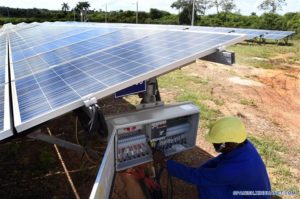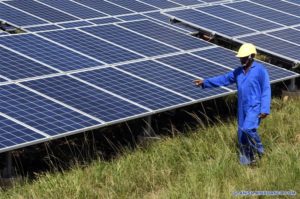 AYUDA CHINA A CUBA EXPLOTA LA ENERGIA SOLAR SUPLANTANDO AL NECESITADO COMBUSTIBLE.
AYUDA CHINA A CUBA EXPLOTA LA ENERGIA SOLAR SUPLANTANDO AL NECESITADO COMBUSTIBLE.
El sol refulge sobre la gigantesca lámina conformada por los paneles solares ubicados en las afueras de la ciudad cubana de Pinar del Río, a unos 150 kilómetros al oeste de La Habana con las banderas de Cuba y China sobresaliendo sobre el Parque solar foto-voltaico Pinar 220 A2, erigido sobre unas 5,8 hectáreas a unos 10 kilómetros al sur de la capital de la provincia del mismo nombre con una donación china de recursos y tecnología.
La instalación, tiene más de 15.500 paneles fabricados por la empresa china Yingli, de la provincia norteña de Hebei.
En la actualidad trabajan en Cuba 65 parques solares y otros 15 están en distintas fases de construcción, para incrementar en 42 GW la potencia instalada actual que aporta el 1,15 por ciento del consumo del país.
El país antillano espera disponer de unos 191 sitios para montar parques solares con una potencia total de 700 MWh y capacidad de generación de 1.050 GW anuales.
Como parte de un programa nacional hasta el año 2030, Pinar del Río tiene identificados 25 áreas destinadas a la construcción de otros parques fotovoltaicos, con los que se espera generar 109 MWh.
“La generación eléctrica se inicia de manera automática a las 08:00 horas (12:00 GMT) y se desconecta, también de manera automática, a las 19:00 (23:00 GMT), cuando el sol empieza a ocultarse; desde que comenzamos a trabajar hasta la fecha, el parque ha generado unos 10.800 Megawatt-hora (MWh), con un ahorro de 2.800 toneladas de combustible”, subraya Molina mientras se acomoda un casco de seguridad antes de salir a recorrer la instalación., explica la directora del la instalación, Rosa María Molina.
No obstante el ahorro de combustible, un tema que es muy sensible para los cubanos, la directora subraya que lo más importante es que “se han dejado de emitir a la atmósfera 9,75 toneladas de dióxido de carbono (CO2)”.
La mujer, una ex maestra de matemáticas que cambió de profesión después de “enamorarse” de la nueva tecnología china, señala que en el lugar generan 4,4 Gigawatts-hora (GWh) por hora, cifra que entregan íntegra al Sistema Eléctrico Nacional.
Para Cuba, que depende casi mayoritariamente del petróleo para generar electricidad, resulta relevante el aporte de las llamadas Fuentes Renovables de Energía, pero especialmente de las solares, pues el Sol pega fuerte en el país caribeño durante casi todo el año.
De acuerdo con expertos cubanos, el país tiene potencialidades para generar 5,0 Kilowatt-hora (KWh) diarios por metro cuadrado.
En la instalación piñarena trabajan 18 personas, quienes se encargan de operar, mantener y custodiar el parque, uno de los ocho que hay en la provincia y que generan en conjunto 18,5 MWh para asumir el 14 por ciento de la demanda eléctrica del territorio. La instalación está diseñada para una vida útil de 25 años, un largo periodo de operaciones que permitirá el ahorro de un alto volumen de combustible y, al mismo tiempo, dejar de emitir grandes cantidades de gases contaminantes a la atmósfera.
Como parte del proceso de reformas que vive la economía cubana, las autoridades prevén que para 2024 el país genere el 24 por ciento de la electricidad mediante fuentes renovables, que incluyen parques solares y eólicos, bioplantas y pequeñas centrales hidroeléctricas.
 CHINA HELPS CUBA EXPLOIT SOLAR ENERGY SUPPLEMENTING SCARCE FUEL.
CHINA HELPS CUBA EXPLOIT SOLAR ENERGY SUPPLEMENTING SCARCE FUEL.
The sun shines on the gigantic sheet formed by the solar panels located on the outskirts of the Cuban city of Pinar del Río, about 150 kilometers west of Havana with the flags of Cuba and China protruding over the photovoltaic solar park Pinar 220 A2, erected on about 5.8 hectares about 10 kilometers south of the capital of the province of the same name with a Chinese donation of resources and technology.
The installation has more than 15,500 panels manufactured by the Chinese company Yingli, from the northern province of Hebei.
Currently, 65 solar parks are working in Cuba and another 15 are in different phases of construction, to increase the current installed power of 1.15 percent of the country’s consumption by 42 GW.
The Antillean country expects to have about 191 sites to mount solar parks with a total power of 700 MWh and a generation capacity of 1,050 GW per year.
SOLAR PANELS IN PINAR DEL RIO.
As part of a national program until 2030, Pinar del Río has identified 25 areas for the construction of other photovoltaic parks, with which it is expected to generate 109 MWh.
“The power generation starts automatically at 08:00 hours (12:00 GMT) and is switched off, also automatically, at 19:00 (23:00 GMT), when the sun begins to hide; from that we started working to date, the park has generated about 10,800 Megawatt-hour (MWh), with a saving of 2,800 tons of fuel, “Molina emphasizes while adjusting a safety helmet before going out to tour the facility.” the director of the installation, Rosa María Molina.
Despite the fuel savings, an issue that is very sensitive for Cubans, the director emphasizes that the most important thing is that “9.75 tons of carbon dioxide (CO2) have ceased to be emitted into the atmosphere.”
The woman, a former math teacher who changed her profession after “falling in love” with the new Chinese technology, notes that they generate 4.4 Gigawatts-hour (GWh) per hour instead, a figure that they deliver in full to the National Electric System.
For Cuba, which depends mostly on oil to generate electricity, the contribution of the so-called Renewable Sources of Energy is relevant, but especially solar, since the Sun hits hard in the Caribbean country during most of the year.
According to Cuban experts, the country has the potential to generate 5.0 Kilowatt-hour (KWh) per day per square meter.
The facility employs 18 people, who are responsible for operating, maintaining and guarding the park, one of eight in the province and together generate 18.5 MWh to assume 14 percent of the territory’s electricity demand. The installation is designed for a useful life of 25 years, a long period of operations that will save a high volume of fuel and, at the same time, stop emitting large amounts of polluting gases into the atmosphere.
As part of the reform process that the Cuban economy is experiencing, the authorities expect that by 2024 the country will generate 24 percent of electricity through renewable sources, including solar and wind farms, bio plants and small hydroelectric plants.
Agencies/ Xinhua/ Raul Menchaca/ Internet Photos & Joaquin Hernandez/ Arnoldo Varona/ www.TheCubanHistory.com
THE CUBAN HISTORY, HOLLYWOOD.









